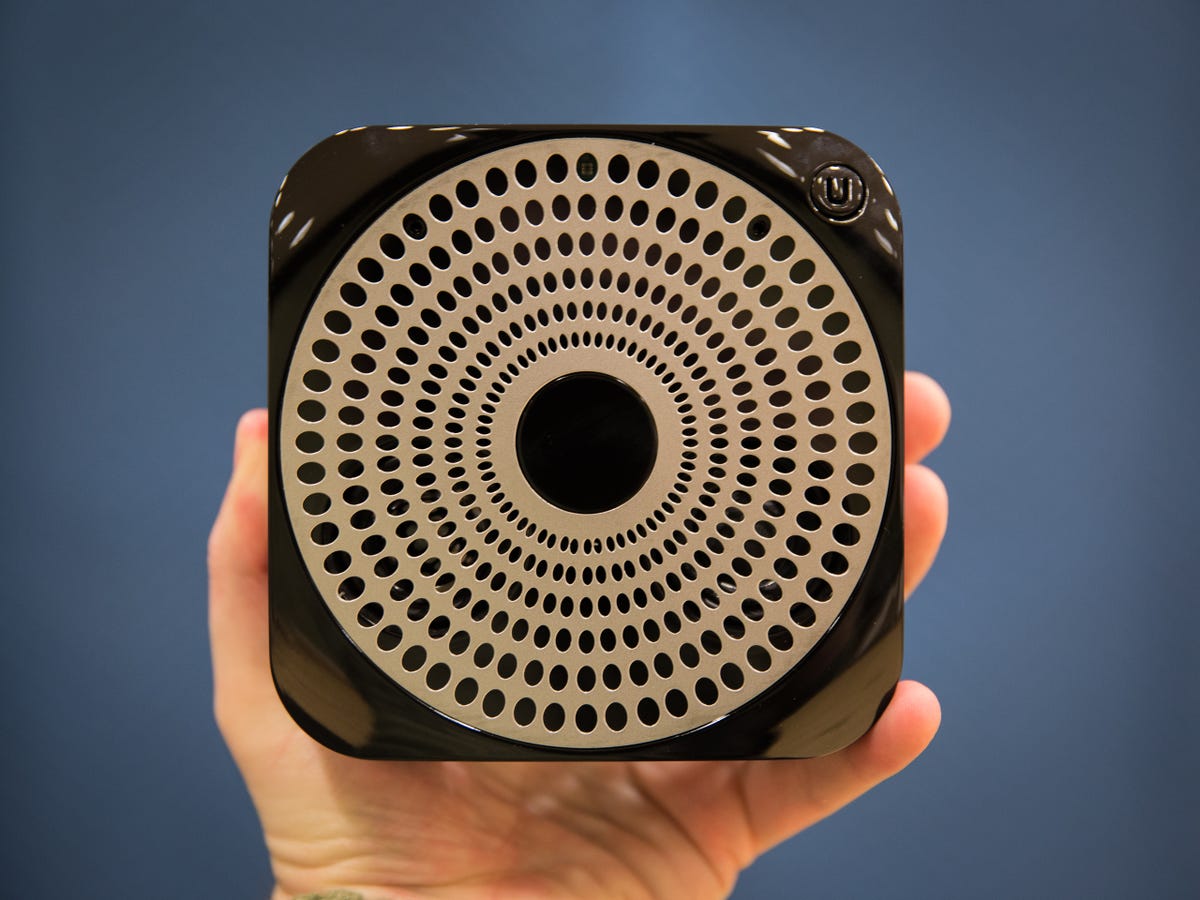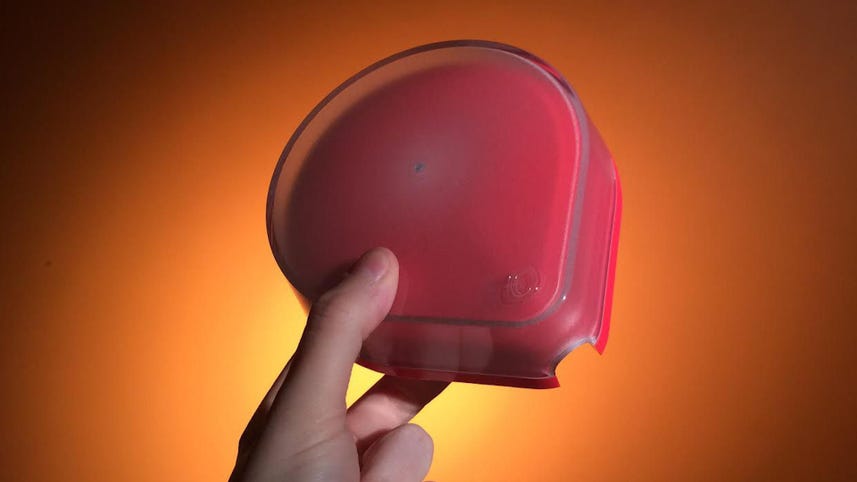 Why You Can Trust CNET
Why You Can Trust CNET 17 smart home gadgets that were way ahead of their time
Timing is everything, and these gadgets and appliances just didn't have it. From favorites that missed their moments to failures probably best left behind us, these are some of the most notable near-misses in the smart home category.

Ubi
Let's start by flashing back to 2014 -- roughly one year before the arrival of the Amazon Echo, and Alexa. Here at CNET Appliances HQ in Louisville, Kentucky, we were busy testing out Ubi, a wall-mounted smart speaker powered by artificial intelligence. Just like Alexa, you could ask Ubi's virtual assistant all sorts of things -- the only difference was that she rarely got it right.
It wasn't just that Ubi's assistant wasn't all that accurate in her answers -- she had a curt confidence about her, too, often following up hilariously wrong replies with an especially snotty-sounding, "Thank you."
One of my favorite examples: I asked Ubi -- which claims to excel at trivia and general knowledge -- for the names of the Ninja Turtles.
"Huey, Duey and Louie," she quickly replied, sounding weirdly annoyed that I had bothered to ask anything at all. "Thank you."
Needless to say, Ubi set the bar nice and low, allowing Alexa to pole vault her way to the top of our minds one year later.
To see UBI in action, take a minute and watch our old video review from four years ago. It's one of my favorites, if only because Megan Wollerton can barely keep it together as Ubi keeps messing up on camera.
Ubi
Seriously, watch the video. It'll make you smile. Go on, I'll wait.
Revolv Smart Home Hub
Speaking of smart home centerpieces that didn't make it, do you remember Revolv? Classy and cool in distinctive red plastic, the Revolv Hub promised to bring order to the chaos of disparate smart home devices by quarterbacking gadgets that wouldn't work together otherwise. It was one of the original smart home hubs -- and a very good one, I might add -- but at $300, it was simply too expensive to break out. Eventually, Revolv was acquired by Nest only to be shuttered shortly thereafter.
Flash forward to today, where smart home hubs from names like SmartThings and Wink that cost a lot less have found their way into enough homes to sustain the business model. Still, part of me wonders if things might have been different had Revolv simply cost a little less. At the very least, the smart home might not be quite so defined by bland white plastic.
Nanoleaf Ivy Smarter Kit
Revolv wasn't the only ahead-of-its-time smart home product that sought to sex up the concept of smart home hubs. Just look at Nanoleaf, a Toronto-based smart lighting startup. Nevermind the inside-out smart bulbs -- the hub was a glowing dodecahedron of doom, the sort of thing you might see sitting on Darth Vader's desk.
When it launched, the Nanoleaf Ivy Smarter Kit hitched its prospects to Apple HomeKit, making it one of the first Siri-compatible smart lighting kits money could buy. Unfortunately, HomeKit compatibility wasn't as big of a draw back then, and the bulbs never really took off as much as Nanoleaf probably would have hoped.
The good news? They're still available today at a surprisingly reasonable price (I recently saw a two-bulb starter kit with the hub on sale for $50). Nanoleaf has also since added compatibility with Alexa, IFTTT and Google Assistant to help broaden the bulbs' appeal.
Nanoleaf Remote
Oh, and Nanoleaf totally still has a huge thing for dodecahedrons. This 12-sided, color-changing HomeKit remote came out just the other month.
Nanoleaf Bloom
And hey, while we're talking Nanoleaf, I might as well mention the Nanoleaf Bloom LED, too. The trademark inside-out jigsaw assembly isn't why it makes the list -- it's because it featured a nifty trick that let folks without dimmer switches dim it up and down just by flicking a normal light switch off and back on. That was nifty back then -- these days, you'll find the same trick from less expensive bulbs from names like Philips and Feit.
Connected by TCP Smart Lighting System
I'm CNET's lighting guy, so you know I'm going to put a bunch of smart bulbs into this gallery. It's who I am.
In fairness, there are also TONS of smart lights that hit the market just a bit too early. Take the Connected by TCP LEDs. They were an early favorite of mine because the bulbs were bright, efficient and, most importantly, way more affordable than Philips Hue, which was one of the only other mainstream competitors at the time
The bulbs had a good run and got lots of premium shelf space at Home Depot, but smart lighting hadn't quite peaked yet. That wouldn't really happen until 2016, when Alexa and the Google Assistant's in-home voice controls led to a huge spike in smart bulb demand. By that point, the TCP kit's moment had passed.
Belkin WeMo LEDs
Chalk up Belkin's short-lived WeMo LEDs as another example of a perfectly decent smart bulb that arrived too early to cash in on the Alexa boom. The bulbs were great, with surprisingly strong color rendering scores, but they cost a little too much. After a while, Belkin decided to shut the lights off.
Stack LED Starter Kit
Originally called Alba LEDs, these Stack LEDs actually made it to the Alexa era, but that wasn't enough to keep them going. With built-in motion detection and ambient light sensors coupled with the ability to automatically shift tones throughout the day to mimic the changing light of the sun, the bulbs were a high-quality option that fell right in line with where in-home lighting is probably headed. Unfortunately, the name change cost the company some momentum, and the kit probably also cost a little too much for people to buy in en masse. Before long, Stack was forced to to pull the plug. Shame, too -- the Stack bulbs were among my favorites.
Green Creative BR30 Cloud LED
It isn't a smart bulb, but I was still struck by the clever design of the Green Creative Cloud LED when I reviewed it back in 2015. At the time, it was an especially weird-looking light that "floated" the light-emitting diodes up above the base of the bulb, where the heat-sensitive hardware is located. That proved to be an effective way of boosting the bulb's performance and efficiency, but it was a little too strange-looking for some folks. Now, three years later, we're seeing all sorts of innovative LED designs, and a higher interest in them from shoppers. Cloud LED, you peaked too soon. Here's looking at you.
Orbnext
OK, I can't help myself, I've got another smart lighting example (I told you there were tons!)
It's called Orbnext, and unlike the name suggests, it was actually cube-shaped. All it offered was a glass enclosure surrounding an Electric Imp chipboard and a set of color-changing LEDs. Aside from acting as a desk ornament, you could connect it with IFTTT to create color-coded ambient alerts -- a change to red when your boss emails, for instance.
Orbnext found its funding on Kickstarter back in 2014, but it never really caught on with anyone outside of geeky home automation hobbyists. As far as I can tell, the company behind it has long since moved on to other ventures -- meanwhile, design-minded color-changing smart gadgets are finally starting to connect with consumers. Orbnext was probably three or four years early.
Homey
How 'bout an actual orb? Like UBI from way back at slide one, the Athom Homey was a voice-activated smart home hub that came out about a year before the Amazon Echo. We never got the chance to test it, but I always had a soft spot for the high-concept design. More weird-looking smart home gadgets, please!
Mycroft Smart Home AI
Here's another voice-activated smart home hub from recent years -- the Mycroft Open Source AI Platform. The company will still sell you one if you like its happy little nerd vibe, and it's currently working on releasing new products, too. Of course, with so much AI competition out there these days, at this point it might actually be a bit late.
Philips Ambilight Televisions
Philips is currently trying to sell us on "Hue Entertainment," which matches your color-changing smart bulbs with whatever's on your screen. The idea isn't new, though -- Philips has been at it for well over a decade, dating all the way back to its "Ambilight" lineup of smart TV sets with built-in color-changing lights. They never took off like Philips had hoped -- the question now is whether or not Hue Entertainment will fare any better.
Samsung touchscreen smart fridges
By this point, we've all become nice and familiar with Samsung's touchscreen-equipped Family Hub smart fridge (at least, those of us who write about appliances for a living have). But the Family Hub wasn't Samsung's first stab at the touchscreen fridge. The idea dates back several years to models like this one, with its comparably tiny touchscreen on the door. It was never the game-changer Samsung hoped it would be, but it paved the way for the Family Hub by showing Samsung what consumers were and were not connecting with.
LG's early Smart ThinQ appliances
These days, LG's gameplan involves putting Wi-Fi radios into each and every appliance it sells, bringing app controls and integrations with Alexa and Google into play. But, like with Samsung, there were a couple of early-gen, proof-of-concept models, like this Wi-Fi oven, that helped to pave the way. None of them ever became connected kitchen breakouts, but they helped LG fine-tune its strategy to ultimately bring us to a time when just about every appliance will be connected in some way.
Hiku
Speaking of the connected kitchen, we were huge fans of the Hiku grocery scanner when we first tested it out three years ago. With the touch of a button, it'd scan the bar codes on your favorite groceries and add them to your shopping list. The problem? Grocery delivery services weren't quite far enough along for Hiku to really make good use of that data. Even in its second generation, the likable device felt underdeveloped as a result.
Quirky Egg Minder
While we're on the topic of kitchen gadgets, how about a slow clap for Quirky? The crowdsourced invention platform produced several high concept smart home gadgets before finally calling it quits in 2015, but I want to give a special shoutout to the Egg Minder, a connected egg tray that helped keep track of expiration dates. It wouldn't surprise me in the least to see tech like this find its way into the smart fridges of the future, but as a standalone device, the idea was just a little too runny.
Picobrew
Picobrew is an app-enabled, in-home beer-brewing system that's been trying to win over the masses for years now. I know, because my colleague Andrew Gebhart uses me as one of his taste-testers every time there's a new version of the product to try out. The beer has always been fine, but never quite good enough (or easy enough) to justify the expense, at least not for me. In other words, it's early, and Picobrew isn't there yet, but give the company credit for stubbornly sticking with the idea and refining it with each new model. One of these days, the timing will be just right.


